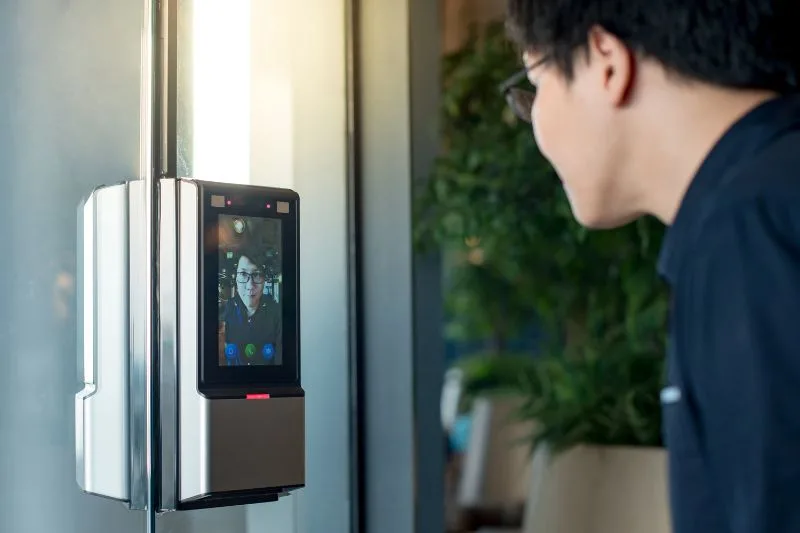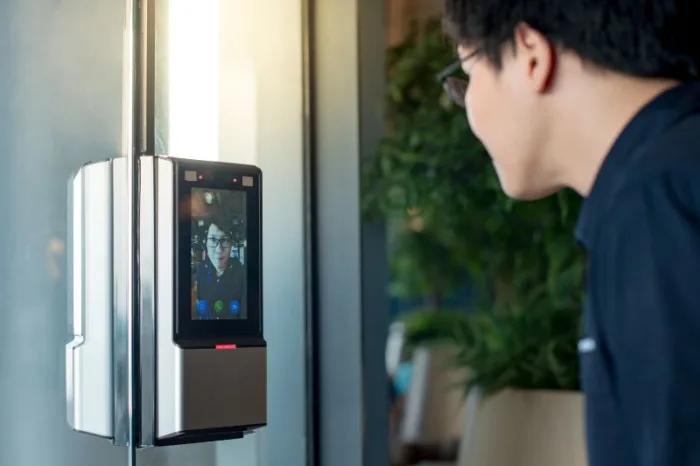Key takeaways
- Facial recognition access control systems provide touchless entry and enhanced security but raise data privacy and accuracy concerns.
- Advancements in AI and multi-modal biometrics are improving facial recognition accuracy, but technical challenges and implementation costs remain barriers.
- Property managers should consider alternative access control methods, such as mobile credentials and key card systems, to balance security, convenience, and compliance.

Facial recognition access control systems are becoming an increasingly popular option for securing commercial and residential properties. As a form of biometric access control, these systems offer a touchless and convenient way to manage building entry.
However, risks surrounding facial recognition technology mean that you and your security professionals must weigh the benefits and challenges carefully. In this post, we explore the role of facial recognition in access control, emerging trends, potential drawbacks, and alternative solutions.
In this post:
- What is face recognition access control?
- Why is biometric access control popular?
- Use cases for facial recognition access control
- 4 facial recognition trends
- What are the disadvantages of a face recognition door lock system?
- A safer, more reliable alternative to facial recognition access control
- Facial recognition access control system FAQs
What is face recognition access control?
A facial recognition access control system uses biometric authentication to verify a person’s identity before granting entry to a building. Instead of traditional keycards, PINs, or fingerprints, it relies on someone’s facial features captured by a scanner to match an individual against a stored database. As such, the technology typically uses 2D or 3D cameras to analyze facial features and create a unique biometric template for each user.
Once programmed into the system, users can access designated areas simply by looking at a camera-equipped biometric face scanner. This hands-free, touchless access control method has increasingly been adopted in workplaces, apartment buildings, and commercial facilities to improve security and convenience.
How does facial recognition access control work?
Facial recognition access control systems use biometric technology to authenticate and grant entry based on a person’s unique facial features.
The process typically involves the following steps:
- Users register their faces with the system, usually by capturing multiple images or a 3D scan through a biometric face scanner or camera.
- Then, the facial template is securely stored in a database, either on a local server or a cloud-based platform.
- When a user approaches a face recognition scanner, the system captures a live image and compares it to stored templates using advanced AI algorithms.
- If the live image matches the stored template accurately, the system grants access by unlocking a door, turnstile, or gate. If not, access is denied, and the event may be logged for security monitoring.
Why is biometric access control popular?
Biometric access control, including facial recognition, offers several advantages over traditional access methods:
- Enhanced security. Unlike keycards or PINs, which can be lost, stolen, or shared, biometric credentials are unique to each individual. This reduces the risk of unauthorized access and security breaches.
- Convenience. Users don’t need to carry physical credentials or remember PIN codes. A face recognition access control system allows authorized individuals to enter seamlessly without additional steps.
- Auditability and access tracking. Biometric building access control systems log every entry attempt, allowing property managers and security teams to monitor access patterns and detect anomalies in real time.
Use cases for facial recognition access control
Facial recognition access control systems are used in a variety of settings where touchless, automated entry can improve security and convenience.
Some common use cases include:
- Multifamily buildings. You can use facial recognition for seamless resident entry, reducing reliance on key fobs or PIN codes while maintaining secure access control.
- Corporate offices. Businesses implement face recognition scanners to enable employees to enter facilities without badges or physical credentials, improving workplace security.
- Hospitals & healthcare facilities. Touchless access reduces the spread of germs while ensuring that only authorized personnel can enter restricted areas, such as operating rooms or pharmaceutical storage.
- High-security facilities. Biometrics, including facial recognition, are used in sensitive locations such as military bases, law enforcement buildings, and research labs to prevent unauthorized entry.
- Educational buildings. Educational institutions use biometric face scanners to enhance security, control access to dormitories and research labs, and manage staff and student entry.
4 facial recognition trends
- Multi-modal biometrics
- Integration with smart building systems
- AI-powered access control
- Privacy-first biometric solutions
1. Multi-modal biometrics
We’re seeing a shift toward multi-modal biometric authentication, which combines facial recognition with other biometric identifiers like fingerprint access control or voice recognition. This approach increases accuracy and security while offering users multiple authentication options.
2. Integration with smart building systems
Facial recognition is being integrated with broader smart building ecosystems. For example, when an employee’s face is recognized at an entry point, the system can trigger personalized settings, such as adjusting office lighting or calling an elevator.
3. AI-powered access control
AI-driven biometric access control is evolving to enhance security and operational efficiency. Cloud-based systems now allow centralized credential management across multiple properties, and AI-powered analytics help detect suspicious access patterns or security threats in real time.
4. Privacy-first biometric solutions
In response to privacy concerns, newer systems prioritize on-device biometric matching rather than storing data in centralized databases. Some facial recognition access control systems now store templates only on a user’s personal device, reducing the risk of data breaches.
What are the disadvantages of a face recognition door lock system?
- Privacy concerns
- Data security risks
- Accuracy and bias
- Implementation costs
- User adoption challenges
Privacy concerns
One of the biggest challenges with biometric access control is privacy. Facial recognition data is highly sensitive, and concerns over surveillance and data misuse have led to legal challenges. For instance, in 2019, tenants of the Atlantic Plaza Towers in Brooklyn successfully fought against a proposed facial recognition entry system due to concerns about constant monitoring.
Many jurisdictions now require explicit consent for biometric data collection. For example, Illinois’ Biometric Information Privacy Act (BIPA) mandates user consent before collecting or storing biometric data.
Data security risks
Biometric data breaches pose significant risks because, unlike passwords, facial biometric credentials cannot be changed. Secure storage methods, such as encryption and tamper-proof processing, are critical to minimizing exposure. Some modern systems use mathematical face templates instead of storing raw images to mitigate security risks.
Accuracy and bias
While facial recognition technology has improved significantly, accuracy issues remain, especially in low-light conditions or with individuals from diverse demographics. Some early versions of the technology exhibited bias, leading to higher false match rates for certain skin tones and genders. While modern deep-learning algorithms have improved accuracy to over 99%, periodic testing and calibration remain necessary.
Implementation costs
Deploying a biometric face scanner system requires significant investment in cameras, sensors, and software. In a survey of security professionals, 33% cited high implementation costs as a barrier to adoption, and 22% were concerned about unclear return on investment. While costs are decreasing as technology advances, integrating facial recognition into existing access control infrastructure remains a challenge.
User adoption challenges
Some users are hesitant to adopt facial recognition due to privacy concerns or discomfort with biometric tracking. Property managers must ensure transparency, provide opt-in options where possible, and offer alternative authentication methods to accommodate user preferences.
Discover how access control systems work:
A safer, more reliable alternative to facial recognition access control
While facial recognition access control offers convenience, its risks make it less than ideal for every building. As an alternative, ButterflyMX’s Access Control System provides a more practical, user-friendly, and secure solution without relying on biometric data.
What’s more, ButterflyMX offers a cloud-based access control system that enhances security while maintaining resident and visitor privacy. Instead of facial recognition, ButterflyMX uses mobile credentials, PIN codes, and key cards for seamless building access.
Here’s why it’s an effective alternative:
- Mobile-based access control. With the ButterflyMX mobile app, users can unlock doors and gates with a smartphone, eliminating the need for physical keys or biometric scans. With these mobile-based features, you can effectively reduce security risks associated with lost credentials and biometric data storage.
- Cloud-managed security. Unlike traditional systems that require expensive on-premise infrastructure, ButterflyMX operates on a cloud-based platform, enabling property managers to control access remotely and view time- and date-stamped photo audits from anywhere.
- Seamless integration. ButterflyMX’s Access Control System integrates with video intercoms, keypads, and elevator controls, allowing properties to create a comprehensive security solution without the need for facial recognition technology.
- Guest & delivery management. Our system simplifies visitor access by allowing residents to grant temporary digital keys or virtual access codes, ensuring secure yet flexible entry for guests, maintenance staff, and delivery drivers.
Facial recognition access control system FAQs
- What is a face ID entry system?
- Is facial recognition access control secure?
- Can facial recognition work in low-light conditions?
What is a face ID entry system?
A face ID entry system uses facial recognition technology to authenticate users before granting access. Similar to Apple’s Face ID, these systems scan and match a person’s face against a database of approved users, allowing touchless and secure entry.
Is facial recognition access control secure?
Facial recognition access control is generally secure but not infallible. Security depends on factors such as liveness detection, encryption, and anti-spoofing measures. While high-end systems incorporate safeguards against deepfake attacks and unauthorized use, vulnerabilities can still arise if biometric data is not adequately protected.
Can facial recognition work in low-light conditions?
Modern facial recognition access control systems use infrared and 3D imaging to enhance performance in low-light environments. However, some lower-quality biometric readers may struggle in dimly lit areas. To mitigate this, many systems integrate supplemental lighting or dual biometric authentication methods.







